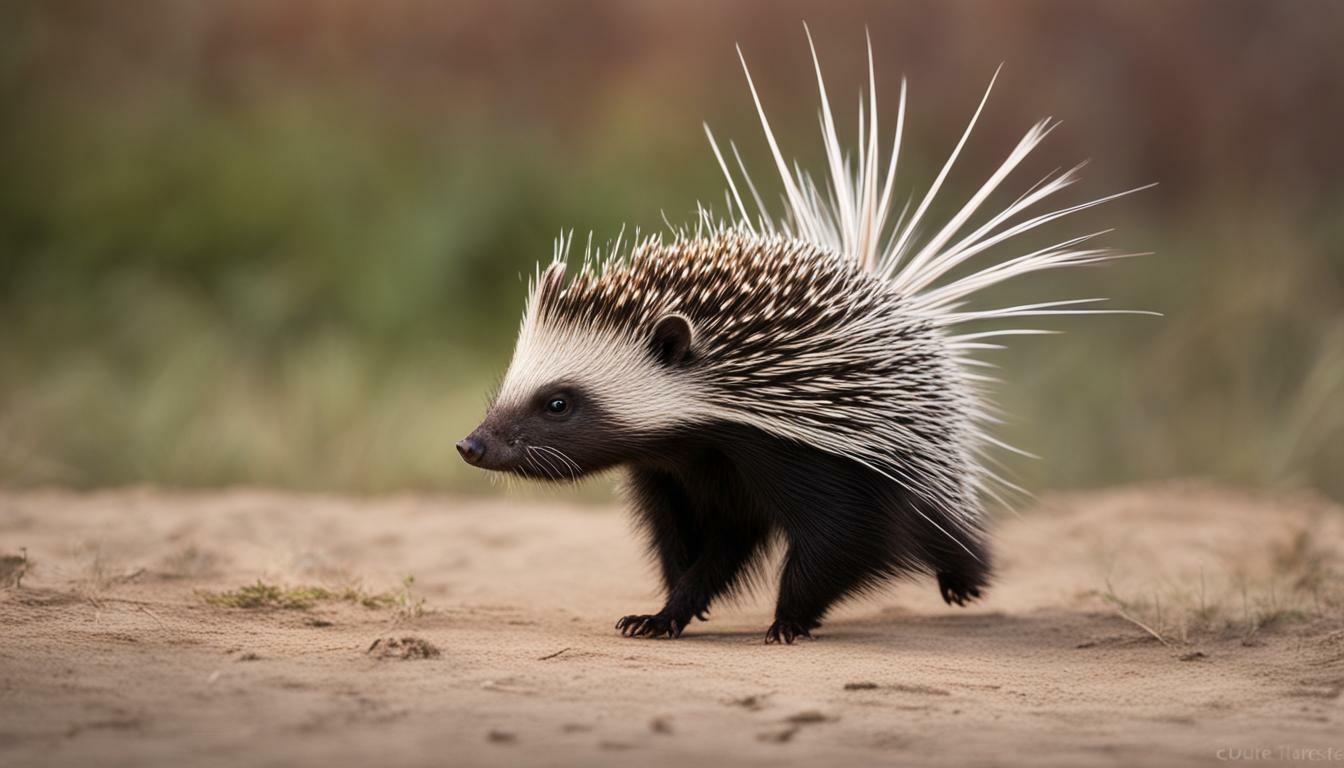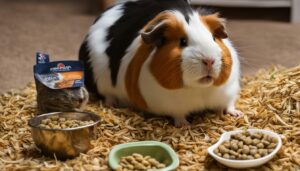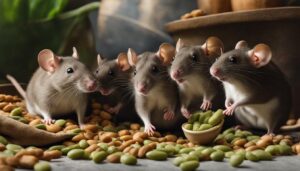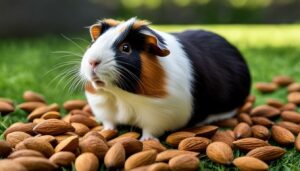Porcupines possess a unique defense mechanism that involves the expulsion of their quills when threatened. These quills, made of keratin, are hard, stiff, and hollow, with small barbs that function like fishing hooks. While the popular belief is that porcupines can shoot their quills like arrows, this is a misconception. In reality, porcupines have to be within tail-swinging distance for the quills to become embedded in their predator’s flesh. The quills can detach easily from the porcupine and one swing of its tail can inflict dozens of quills.
Porcupines are not aggressive by nature and will only defend themselves if they feel threatened. If humans or pets come into contact with porcupines and get quilled, immediate medical attention is necessary to prevent further complications. It is important to understand that porcupines cannot shoot their quills at all. Instead, they rely on physical contact with a predator to lodge the quills.
Key Takeaways:
- Porcupines cannot shoot their quills like arrows; physical contact is necessary for quill deployment.
- Quills are made of keratin, hard and stiff, with small barbs that make them difficult to remove.
- Porcupines have to be within tail-swinging distance for quills to become embedded in their predator’s flesh.
- One swing of the porcupine’s tail can inflict dozens of quills.
- If humans or pets come into contact with quills, immediate medical attention is necessary.
Understanding Porcupine Quills
Porcupine quills, which are composed of keratin, are hard, stiff, and hollow structures that play a crucial role in the porcupine’s self-defense. These sharp, needle-like structures are typically found on the porcupine’s back, sides, and tail. When a porcupine feels threatened, it will raise its quills as a warning sign to potential predators. Contrary to popular belief, porcupines cannot shoot their quills like arrows; instead, they rely on physical contact with a predator to lodge the quills.
The anatomy of porcupine quills is fascinating. Each quill has a pointed tip that tapers to a sharp point, allowing them to easily penetrate the skin of potential threats. Along the shaft of the quill, small barbs are present, resembling tiny fishing hooks. These barbs make it relatively easy for the quills to slide into the flesh of the predator, but difficult for them to be pulled out. The barbs function as a defense mechanism, ensuring that the quills remain embedded in the predator’s skin.
It is important to note that porcupines are not aggressive by nature and will only use their quills as a last resort when they feel threatened. When a porcupine is approached by a predator, it will often turn its back and swish its tail in an attempt to strike the predator with its quills. The quills detach easily from the porcupine’s skin and can be propelled towards the predator with a single swing of its tail. One swing is often enough to inflict dozens of quills, making it a potent defensive strategy.
Table: Comparing Porcupine Quills to Other Defensive Mechanisms
| Defense Mechanism | Strength | Range | Effectiveness |
|---|---|---|---|
| Porcupine Quills | Hard, stiff, and sharp | Within tail-swinging distance | High, difficult to remove |
| Spines of Hedgehogs | Short and sharp | Close contact | Moderate, painful but removable |
| Thorns of Plants | Sharp and pointed | Close contact | Low, easily removable |
If a human or a pet gets quilled, immediate medical attention is necessary. The barbed structure of the quills makes them difficult to remove, and attempting to do so without proper medical expertise can lead to further complications. It is important to seek professional help to minimize the risk of infection and ensure a safe and proper removal process.
In conclusion, porcupine quills are remarkable adaptations that enable porcupines to defend themselves effectively. These keratin-based structures are hard, stiff, and hollow, with barbs that make them easy to penetrate but challenging to withdraw. While porcupines cannot shoot their quills, they can swiftly swing their tails to detach and propel the quills towards a predator. Understanding the anatomy and behavior of porcupine quills is crucial to appreciate their unique defense mechanism and foster a respectful coexistence with these fascinating creatures.
How Porcupine Quills Work
When threatened, porcupines can quickly and forcefully expel their quills, using a combination of muscle contractions and precise movements. These quills, which are made of keratin, are hard, stiff, and hollow, allowing them to be propelled from the porcupine’s body with considerable force. The quills have small barbs that function like fishing hooks, making them easy to slide into a predator’s flesh but difficult to remove.
Porcupines can detach their quills easily, and a single swing of their tail can inflict dozens of quills on a predator. The expulsion of quills is a form of self-defense for porcupines, as they rely on physical contact with a predator to lodge the quills. While the porcupine’s quills cannot be shot like arrows, they are an effective deterrent when the porcupine is within tail-swinging distance of a predator.
Understanding Porcupine Quills
To understand how porcupine quills work, it is important to delve into their anatomy. Quills are composed of a hard outer layer and a softer inner core. This structure allows the quills to be rigid yet lightweight. The barbs on the quills face backward, making them difficult to remove once embedded in a predator’s skin. The barbs also help the quills to stay anchored in the predator’s flesh, increasing the likelihood of causing pain and discomfort.
It’s worth noting that porcupines are not aggressive by nature and will only deploy their quills if they feel threatened. Their primary defense mechanism is to rely on their quills as a deterrent, displaying them to potential predators as a warning sign. If a predator persists, the porcupine will engage in defensive behaviors like raising its quills, hissing, and shaking its tail to create a visual and auditory warning. These behaviors, along with the quills themselves, serve as a formidable defense against most predators.
| Porcupine Quill Facts |
|---|
| Quills are made of keratin, the same material found in human hair and nails. |
| Porcupine quills are sharp and can cause injury if handled carelessly. |
| Quills can become embedded in a predator’s skin and cause pain, discomfort, and potential infection. |
| If a human or pet is quilled by a porcupine, immediate medical attention is necessary to prevent further complications. |
| Porcupines do not shoot their quills; physical contact is required for quill deployment. |
In conclusion, porcupine quills are a remarkable defense mechanism that can be deployed when a porcupine feels threatened. Although they cannot be shot like projectiles, porcupines have developed a unique way to expel their quills with force and accuracy, using muscle contractions and precise movements. Their quills, with their barbs and detachable nature, make them an effective deterrent against potential predators, as well as a potential danger to humans and pets. It is important to understand and respect the porcupine’s defense mechanisms and seek immediate medical attention if quilled, to ensure a swift and safe recovery.
The Range of Porcupine Quills
Porcupines need to be within a certain distance from their adversary for their quills to effectively embed themselves in the predator’s flesh. These distinctive quills, made of keratin, are hard, stiff, and hollow. They possess small barbs that function like fishing hooks, allowing them to slide easily into a predator’s skin but making removal a challenging task.
Quills can detach effortlessly from the porcupine, and a single swing of its tail can inflict dozens of these sharp projectiles. While porcupines are not naturally aggressive creatures, they will defend themselves if they feel threatened or cornered. To protect themselves, they rely on physical contact with a predator to lodge their quills effectively.
It is important to note that porcupines cannot shoot their quills like arrows. Although they possess an impressive defense mechanism, their range of quill deployment is limited to close proximity. Porcupines are not capable of launching their quills at a distance, contrary to popular misconception.
| Porcupine Quills | Key Characteristics |
|---|---|
| Composition | Made of keratin, hard, stiff, and hollow |
| Barbs | Function like fishing hooks, making them easy to slide in but difficult to remove |
| Detachment | Easily detachable from the porcupine’s body |
| Defense Strategy | Relies on physical contact with predators to lodge quills effectively |
If humans or pets encounter a porcupine and are quilled, immediate medical attention is crucial to prevent further complications. Porcupine quills can cause pain, inflammation, and infection if not properly addressed. It is vital to understand that porcupines do not possess the ability to shoot their quills at all; their defense mechanism relies solely on close contact with the predator.
Barbed Quills and Defense Mechanism
The small barbs on porcupine quills act like fishing hooks, making it easy for them to penetrate a predator’s skin but difficult to remove. These quills are made of keratin, the same material found in our nails and hair, which renders them hard, stiff, and hollow. When a porcupine feels threatened, it will fluff up its quills, making them stand on end, ready to defend itself.
When a predator comes into contact with the porcupine, the barbs on the quills become embedded in the predator’s flesh. The more the predator tries to remove the quills, the deeper they become entangled. The quills are designed this way to ensure that once they are lodged, they are incredibly challenging to dislodge.
Porcupines possess a remarkable ability to detach their quills, allowing them to easily defend themselves. With just one swing of their tail, they can inflict dozens of quills into their predator. This defense mechanism not only delivers a painful reminder to the attacker but also increases the chances of quill dislodgment, causing further discomfort and potential injury.
| Porcupine Quill Characteristics | Porcupine Quill Function |
|---|---|
| Hollow | Enables quills to become embedded in predator’s flesh |
| Hard and Stiff | Provides rigidity for quills to penetrate predator’s skin |
| Small Barbs | Makes quill removal difficult for predator |
| Ability to Detach | Allows for multiple quill deployments with one tail swing |
While porcupines are not aggressive by nature and prefer to avoid confrontations, they will defend themselves when necessary. It is important to remember that if you or your pet happens to get quilled, immediate medical attention is vital to prevent further complications. Porcupines cannot shoot their quills like arrows; they rely on physical contact with a predator for the quills to become lodged.
Quill Detachment and Infliction
A single swing of a porcupine’s tail can lead to the infliction of numerous quills, causing significant discomfort and danger to its adversaries. These quills, made of keratin, are hard, stiff, and hollow, with small barbs that function like fishing hooks. The barbs make it easy for the quills to slide into a predator’s flesh but difficult to remove.
Porcupines have the ability to detach their quills easily from their bodies, making them formidable weapons. When threatened, a porcupine will arch its back, raise its quills, and swing its tail forcefully. This motion sends a barrage of quills flying towards the predator, embedding them deep into the attacker’s skin.
Human encounters with porcupines can lead to quill injuries, especially if there is physical contact. If you or your pet are unfortunate enough to be quilled, it is crucial to seek immediate medical attention. Removing the quills yourself can cause further complications, as they are designed to penetrate deeply and can break off inside the skin.
| Porcupine Quill Danger | Precautions |
|---|---|
| Quills can cause pain and discomfort | Seek medical attention for proper removal |
| Quills can become embedded deep into the skin | Do not attempt to remove quills yourself |
| Quills can break off inside the skin | Immediate medical attention is necessary |
Despite popular belief, porcupines cannot shoot their quills like arrows. They rely on the physical contact of a predator to lodge the quills securely. The barbed quills effectively deter most predators, as the pain and discomfort caused by their presence act as a powerful deterrent.
Porcupine Behavior and Defense
Porcupines, by nature, are not aggressive animals and will only deploy their quills as a defense mechanism when they feel threatened. These fascinating creatures rely on their unique quills to protect themselves from potential predators, showcasing an intricate defense strategy that has evolved over time.
Equipped with quills that are made of keratin, the same material found in our hair and nails, porcupines possess a formidable defense mechanism. These quills are hard, stiff, and hollow, allowing them to be easily embedded into the flesh of an attacker. The small barbs present on the quills act like fishing hooks, making it difficult for predators to remove them once they have been lodged in their skin.
When a porcupine feels threatened, it will swing its tail with remarkable accuracy, resulting in the expulsion of dozens of quills in a single motion. This tail-swinging behavior allows the porcupine to maximize the chances of deterring an attacker, as the quills can be launched towards any potential threat within range.
The Role of Quill Detachment
Porcupines have the ability to detach their quills easily, making their defense mechanism even more effective. One swing of their tail can inflict a significant number of quills into an attacker, increasing the likelihood of the predator retreating due to the discomfort caused by the embedded quills.
It is crucial to note that porcupines cannot shoot their quills like arrows. Instead, physical contact with a predator is necessary for the quills to become embedded. This dispels the myth that porcupines can launch their quills from a distance. Their defense mechanism relies on close proximity and the precise tail-swinging motion to inflict quill injuries.
If humans or pets happen to encounter a porcupine and get quilled, seeking immediate medical attention is essential. The barbs on the quills can cause further complications if not properly removed. Therefore, it is crucial to address the situation promptly to prevent any potential long-term effects or injuries.
| Key Points: |
|---|
| Porcupines deploy their quills as a defense mechanism when threatened. |
| Quills are made of keratin and contain small barbs, making them difficult to remove. |
| Porcupines can easily detach their quills, inflicting numerous quills with one tail swing. |
| Quills can only become embedded through physical contact, dispelling the notion of shooting quills from a distance. |
| Immediate medical attention is necessary if quilled to prevent complications. |
Human Encounters and Medical Attention
If humans or pets come into contact with porcupine quills, prompt medical attention is crucial to prevent further complications and ensure proper removal. Porcupines cannot shoot their quills like arrows; they rely on physical contact with a predator to lodge the quills. Quills are made of keratin and are hard, stiff, and hollow. They are equipped with small barbs that function like fishing hooks, allowing them to easily slide into the flesh of a predator but making them difficult to remove.
When a porcupine feels threatened, it can swing its tail, inflicting dozens of quills in one motion. These quills can detach easily from the porcupine and become embedded in the predator’s skin. It is essential to seek immediate medical attention for quill removal because leaving them in can lead to serious complications, such as infection and tissue damage. Additionally, attempting to remove the quills without proper training and tools can cause further injury.
Medical professionals have the expertise and equipment necessary to safely remove porcupine quills. They will carefully extract each quill one by one, ensuring that all fragments are removed from the affected area. In some cases, anesthesia may be required to minimize pain and discomfort during the removal process.
Remember, prevention is key when it comes to porcupine encounters. Avoid approaching or provoking these animals to minimize the risk of quill injuries. If you or your pet do come into contact with porcupine quills, do not attempt to remove them yourself. Seek immediate medical attention to prevent complications and ensure proper treatment.
| Key Points: | |
|---|---|
| Porcupines cannot shoot their quills like arrows. | Quills must make physical contact to become embedded. |
| Quills are made of keratin and have small barbs. | They can easily slide into flesh but are difficult to remove. |
| Seek prompt medical attention for proper quill removal. | Leaving quills in can lead to complications. |
| Medical professionals are trained to safely remove quills. | Anesthesia may be used to minimize discomfort. |
| Avoid approaching or provoking porcupines. | Prevention is key to avoiding quill injuries. |
Debunking the Myth of Quill Shooting
Contrary to popular belief, porcupines cannot shoot their quills like arrows; they rely on physical contact with predators to lodge their quills. Quills are made of keratin, the same material found in human hair and nails. They are hard, stiff, and hollow, with small barbs that function like fishing hooks. These barbs make it easy for the quills to slide into the predator’s flesh, but difficult to remove once embedded.
Porcupines have a unique defense mechanism where their quills can detach easily from their bodies. When a porcupine feels threatened, it will rapidly swing its tail, and in one swift motion, dozens of quills can be unleashed. The quills are propelled towards the predator, becoming embedded in its skin. This can be a painful experience for the predator, as the barbs make it challenging to remove the quills without causing further injury.
It is important to note that porcupines are not aggressive by nature and will only defend themselves if they feel threatened. However, if a human or pet happens to be quilled, immediate medical attention is necessary. The quills can cause infections, abscesses, and other complications if left untreated. So, it is crucial to seek professional care to ensure proper removal and prevent any further harm.
| Myth | Fact |
|---|---|
| Porcupines can shoot their quills like arrows. | Porcupines rely on physical contact with predators to lodge their quills. |
| Quills are solid. | Quills are hollow and have barbs that make them difficult to remove. |
| Porcupines are aggressive animals. | Porcupines are not aggressive by nature and will only defend themselves when threatened. |
In conclusion, the myth of porcupines shooting their quills like arrows is just that – a myth. Porcupines rely on close physical contact to protect themselves by deploying their quills. Understanding the mechanics and limitations of porcupine quills is essential for mitigating any potential risks associated with encounters between humans or pets and these fascinating creatures.
Conclusion
By unraveling the mystery of how far a porcupine can throw its quills, we gain valuable insights into the intricate self-defense tactics employed by these fascinating creatures. Porcupines cannot shoot their quills like arrows. Instead, they rely on physical contact with a predator to lodge the quills, ensuring that they are within tail-swinging distance. Quills are made of keratin and are hard, stiff, and hollow, with small barbs that function like fishing hooks. This design makes them easy to slide into a predator but difficult to remove.
When threatened, porcupines can detach their quills easily, using one swing of their tail to inflict a barrage of dozens of quills. However, porcupines are not aggressive by nature. They will only defend themselves if they feel threatened. If humans or pets come into contact with porcupine quills, immediate medical attention is necessary to prevent further complications.
While the idea of porcupines shooting their quills from a distance is a common misconception, it is important to understand that physical contact is essential for quill deployment. By examining the anatomy and behavior of porcupines, we can debunk this myth. By doing so, we gain a deeper understanding of the impressive defense mechanism of porcupines and the importance of respecting their space.
In conclusion, porcupines possess an extraordinary defense mechanism through their quills, which serve as a formidable deterrent against potential predators. Through the combination of their unique quill anatomy, barbed design, and the ability to detach and inflict numerous quills in one swing, these remarkable creatures effectively protect themselves. By dispelling misconceptions and understanding how porcupines defend themselves, we can coexist harmoniously with these fascinating animals, appreciating their remarkable adaptations.
FAQ
Can porcupines shoot their quills like arrows?
No, porcupines cannot shoot their quills like arrows. They rely on physical contact with a predator to lodge the quills.
What are porcupine quills made of?
Porcupine quills are made of keratin, which is a hard, stiff, and hollow material.
How do porcupine quills attach to predators?
Porcupine quills have small barbs that function like fishing hooks, making them easy to slide into a predator but difficult to remove.
How many quills can a porcupine release in one swing of its tail?
One swing of a porcupine’s tail can inflict dozens of quills.
Are porcupines aggressive by nature?
No, porcupines are not aggressive by nature. They will only defend themselves if they feel threatened.
What should I do if I or my pet gets quilled by a porcupine?
Immediate medical attention is necessary to prevent further complications if you or your pet gets quilled by a porcupine.
Can porcupines shoot their quills from a distance?
No, porcupines cannot shoot their quills at a distance. They need to be within tail-swinging distance for the quills to become embedded in their predator’s flesh.
How easy are porcupine quills to detach from the porcupine?
Porcupine quills can detach easily from the porcupine’s body.
Do porcupines use their quills as their primary defense mechanism?
Yes, porcupines use their quills as their primary defense mechanism when they feel threatened.
Is it true that porcupines can shoot their quills?
No, it is a misconception that porcupines can shoot their quills. They rely on physical contact with a predator to lodge the quills.




